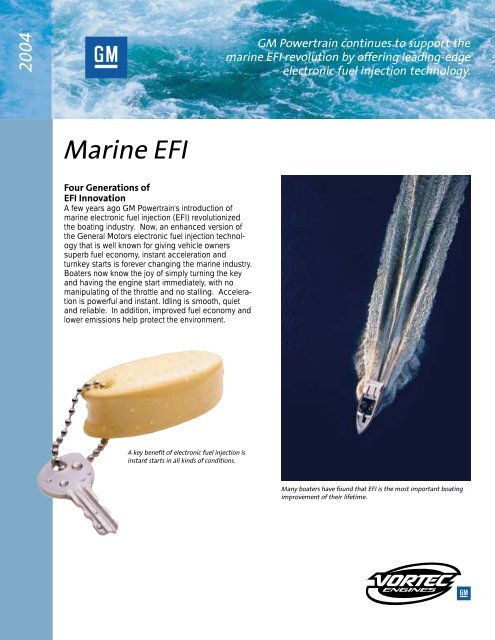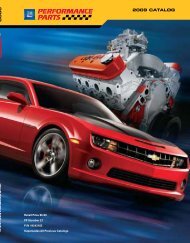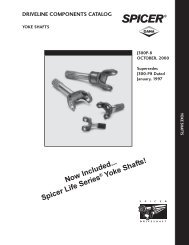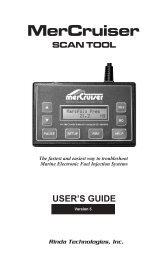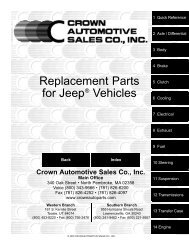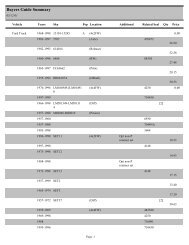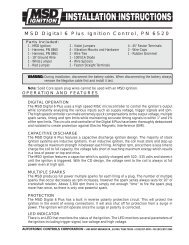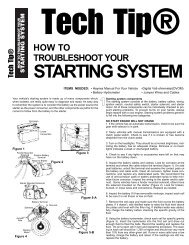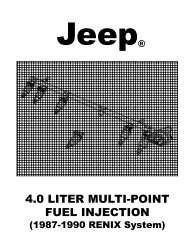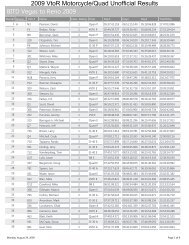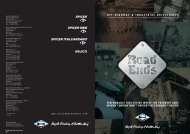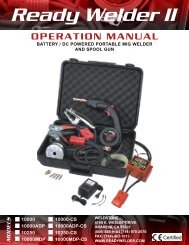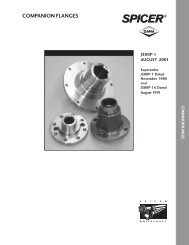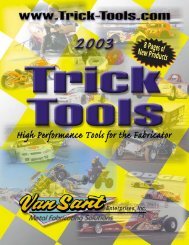GM Powertrain Marine EFI brochure, 2004. - Pirate4x4.Com
GM Powertrain Marine EFI brochure, 2004. - Pirate4x4.Com
GM Powertrain Marine EFI brochure, 2004. - Pirate4x4.Com
You also want an ePaper? Increase the reach of your titles
YUMPU automatically turns print PDFs into web optimized ePapers that Google loves.
2004<br />
<strong>GM</strong> <strong>Powertrain</strong> continues to support the<br />
marine <strong>EFI</strong> revolution by offering leading-edge<br />
electronic fuel injection technology<br />
<strong>Marine</strong> <strong>EFI</strong><br />
Four Generations of<br />
<strong>EFI</strong> Innovation<br />
A few years ago <strong>GM</strong> <strong>Powertrain</strong>'s introduction of<br />
marine electronic fuel injection (<strong>EFI</strong>) revolutionized<br />
the boating industry. Now, an enhanced version of<br />
the General Motors electronic fuel injection technology<br />
that is well known for giving vehicle owners<br />
superb fuel economy, instant acceleration and<br />
turnkey starts is forever changing the marine industry.<br />
Boaters now know the joy of simply turning the key<br />
and having the engine start immediately, with no<br />
manipulating of the throttle and no stalling. Acceleration<br />
is powerful and instant. Idling is smooth, quiet<br />
and reliable. In addition, improved fuel economy and<br />
lower emissions help protect the environment.<br />
A key benefit of electronic fuel injection is<br />
instant starts in all kinds of conditions<br />
Many boaters have found that <strong>EFI</strong> is the most important boating<br />
improvement of their lifetime
2004<br />
A Fourth-Generation, State-of-the-Art<br />
Electronic Control Module<br />
The “Brain” of the System Ties It All Together<br />
A key factor in <strong>EFI</strong>'s success was <strong>GM</strong> <strong>Powertrain</strong>'s<br />
marine <strong>EFI</strong> Electronic Control Module (ECM), which was<br />
developed specifically for the marine industry.<br />
Its thick-film hybrid technology is more advanced than<br />
the circuit board technology used in much of the<br />
automotive industry.<br />
The Benefits of Hybrid Technology<br />
<strong>GM</strong> <strong>Powertrain</strong>'s marine ECM is manufactured using a<br />
state-of-the-art, thick-film “hybrid” technology that<br />
forms the circuits by literally “printing” layers of<br />
conductive and nonconductive ink onto a ceramic<br />
substrate. The result is an extremely rugged and<br />
durable circuit board that can be mounted directly onto<br />
the engine, because it can handle very high temperatures<br />
and severe vibrations.<br />
Small, Light Package<br />
Extensive use of “flip chip” integrated circuit technology<br />
makes possible a smaller ECM. Flip chips require<br />
less space because they do not have the plastic covering<br />
of typical chips and are “flipped” over to fasten<br />
directly to the board,<br />
An ECM with Exceptional Capabilities<br />
<strong>GM</strong> <strong>Powertrain</strong>'s fourth-generation ECM has several<br />
important capabilities and features.<br />
Coil-Near-Plug Capability<br />
Provides the OEM the opportunity to incorporate a<br />
coil-near-plug ignition system for more accurate<br />
ignition timing and better spark.<br />
CAN Interface Capability<br />
Controller Area Network (CAN) protocol allows the<br />
controller to communicate with other electronic<br />
devices in the boat.<br />
Integrated Knock Control<br />
Incorporating the knock control module into the ECM<br />
eliminates the interface electronics module, which is<br />
located between the knock sensor and the ECM. The<br />
knock control module is software programmable,<br />
instead of hardwired, so parameters can be updated<br />
via software.<br />
Optional Inputs and Outputs<br />
OEMs are offered several optional inputs and outputs<br />
to use for adding more features and capabilities.<br />
The new, fourth-generation <strong>EFI</strong> electronic control<br />
module has coil-near-plug and CAN interface<br />
capabilities
2004<br />
<strong>Marine</strong> <strong>EFI</strong><br />
<strong>EFI</strong> has Revolutionized the Boating<br />
Experience<br />
Electronic fuel injection, combined with microprocessor-based<br />
engine management, has dramatically<br />
changed the entire boating experience.<br />
What <strong>EFI</strong> means to the Boater and Family<br />
• More responsive and smoother acceleration is the<br />
result of the <strong>EFI</strong> system's ability to instantly deliver an<br />
atomized flow of fuel for as long as needed.<br />
• Excellent turnkey starts in all weather conditions are<br />
made possible because the ECM can sense whether<br />
the engine is cold from morning chill or hot from heavy<br />
use and then provide the right amount of fuel for<br />
instant starts.<br />
• Smooth, reliable idling comes from the ECM's ability<br />
to provide the correct amount of air and fuel during<br />
idling. This results in reliable idling, whether the engine<br />
is hot or cold, and no stalling while moving in and out of<br />
gear.<br />
• Significantly reduced fuel consumption is due to the<br />
precision of the electronic engine management<br />
system.<br />
• Improved control of emissions is also due to the<br />
precision of <strong>EFI</strong>.<br />
• Engine knock control is attained by detecting engine<br />
knock and then virtually eliminating it by automatically<br />
changing the spark timing and fuel delivery. This<br />
means a tank of less-than-perfect gasoline will not<br />
ruin a boating weekend.<br />
• Overspeed protection means that engine rpm is<br />
automatically limited if there is a danger of the<br />
engine overspeeding due to the propeller failing or<br />
coming out of the water.<br />
• Speed reduction reduces engine speed and beeps a<br />
warning if one of the inputs to the ECM indicates an<br />
operating condition that is out of proper limits.<br />
Operating conditions that cause speed reduction<br />
could include engine overheating, low oil level, and low<br />
oil pressure.<br />
• Altitude compensation is a welcome help for boaters<br />
who sometimes vacation in higher altitudes. The<br />
ECM system senses air density and modifies fuel and<br />
spark accordingly.<br />
• Self-diagnostic capabilities make for faster, more<br />
accurate maintenance on those rare occasions when<br />
the <strong>EFI</strong> system needs servicing.<br />
• Reduced maintenance results from replacing the<br />
complex carburetor with the simple <strong>EFI</strong> system.<br />
• Improved resale value is due to all of the above<br />
features and the fact that <strong>GM</strong> <strong>Powertrain</strong>’s <strong>EFI</strong><br />
system is designed specifically to maintain superior<br />
performance year after year in the harsh marine<br />
environment.<br />
Announcing Enhanced <strong>EFI</strong> Software<br />
OEMs can choose an improved version of the fourth-generation Commercial Electronic<br />
Fuel Injection software.<br />
<strong>GM</strong> <strong>Powertrain</strong> has developed a new "B" version<br />
of the software used to control the marine <strong>EFI</strong><br />
system that offers several additional improvements:<br />
• Controller Area Network (CAN) Bus<br />
Enhancements<br />
• Significant increase to the number of J1939<br />
broadcast messages<br />
• Option to interface EGR input to fuel level<br />
sensor to broadcast on CAN<br />
• J1939/73 Diagnostics and Service Tool<br />
interface<br />
• Support for CAN-based calibration tools<br />
• Fuel Control Enhancements<br />
• Independent closed-loop fuel calibrations for<br />
dual-fuel appplications<br />
• Improved fuel control algorithms<br />
• Idle Control Enhancements<br />
• Improved idle control algorithm<br />
• Idle Fuel Control (New feature)<br />
• ETC/Governor Control Enhancements<br />
• Knock Control and Octane Rating Enhancements<br />
• EGR Revisions to Allow for Alternate Uses of EGR<br />
Output
2004<br />
Electronic Engine Management System<br />
The technology behind electronic engine management is very sophisticated, but the basic concepts<br />
are easy to understand. The diagram below shows the major inputs that the ECM continuously<br />
monitors and the major outputs that it precisely controls for both an MSTS and <strong>EFI</strong> system.<br />
INPUTS<br />
OUTPUTS<br />
RPM/Crank/Cam Position Signal<br />
Compatible with 4-, 6-, and 8-cylinder<br />
engines<br />
MAP Sensor<br />
Manifold Absolute Pressure (MAP)<br />
sensor allows for altitude compensation<br />
and load correction. Boosted systems<br />
are also supported.<br />
Coolant Sensor<br />
Operating temperature fuel/spark<br />
adjustments and engine over-temp<br />
protection<br />
Knock Signal<br />
Detects and protects engine from<br />
detonation and adapts system to<br />
octane levels<br />
Throttle Sensor<br />
Closed throttle idle determination<br />
and acceleration control<br />
MAT Sensor<br />
Modifies fuel and spark delivery<br />
for changes in intake Manifold Air<br />
Temperature (MAT)<br />
Oxygen Sensors<br />
Supports both narrow-band and<br />
wide-range sensors to provide<br />
closed-loop control to desired A/F ratio<br />
Shift Interrupt<br />
To facilitate shifting in and out of gear<br />
Electronic Throttle Control Interface<br />
Eliminates problematic throttle cables<br />
and allows twin engine synchronization<br />
and cruise control<br />
Other Inputs<br />
• Vessel speed<br />
• Oil pressure<br />
• Fuel pressure<br />
• Emergency stop<br />
• Diagnostic/field service mode<br />
• Catalytic converter temperature<br />
• General warning detection (2)<br />
Electronic<br />
Control<br />
Module<br />
Multiple EST Signals<br />
Compatible with HEI and HVS distributors,<br />
DIS coil packs, and coil-near-plug ignition<br />
systems<br />
Bypass<br />
This signal is used in conjunction with<br />
the HEI distributors. It coordinates the<br />
transition from crank spark (backup spark)<br />
mode and run spark mode.<br />
Injector Drivers<br />
Two outputs to drive multi-port (banked<br />
saturated switch), TBI (peak-and-hold), or<br />
alternative fuel injectors. The characteristics<br />
of the driver are defined by calibration.<br />
EGR Driver<br />
Exhaust Gas Recirculation valve driver to<br />
meet emissions standards<br />
CCP Driver<br />
Charcoal Canister Purge driver to meet<br />
emissions standards<br />
Idle Air Control Valve<br />
Maintains perfect idle speed with the IAC<br />
stepper motor and spark stabilization<br />
Twin Engine Synchronization<br />
Using electronic throttle controls, engine<br />
rpm can be synchronized for smooth,<br />
efficient operation of twin-engine<br />
applications.<br />
Fuel Pump Relay Drive<br />
Intelligent control of the fuel pump based<br />
on fuel pressure and engine status<br />
Serial Communications<br />
One bus provides a user-friendly interface<br />
for service and calibration tools. The<br />
second provides a CAN bus interface.<br />
RPM-Based Output<br />
This output changes state (on/off) as<br />
engine rpm crosses calibration thresholds.<br />
Other Outputs<br />
• Check Engine lamp<br />
• Check Gauges lamp<br />
• Low Oil Level lamp<br />
• System Warning alarm<br />
• Tachometer signal<br />
• Twin Engine Synch Status lamp<br />
• General Warning lamps (2)<br />
<strong>GM</strong> <strong>Powertrain</strong><br />
www.gmpowertrain.com<br />
© 2003 General Motors Corporation<br />
PRINTED IN U.S.A. 8/03


